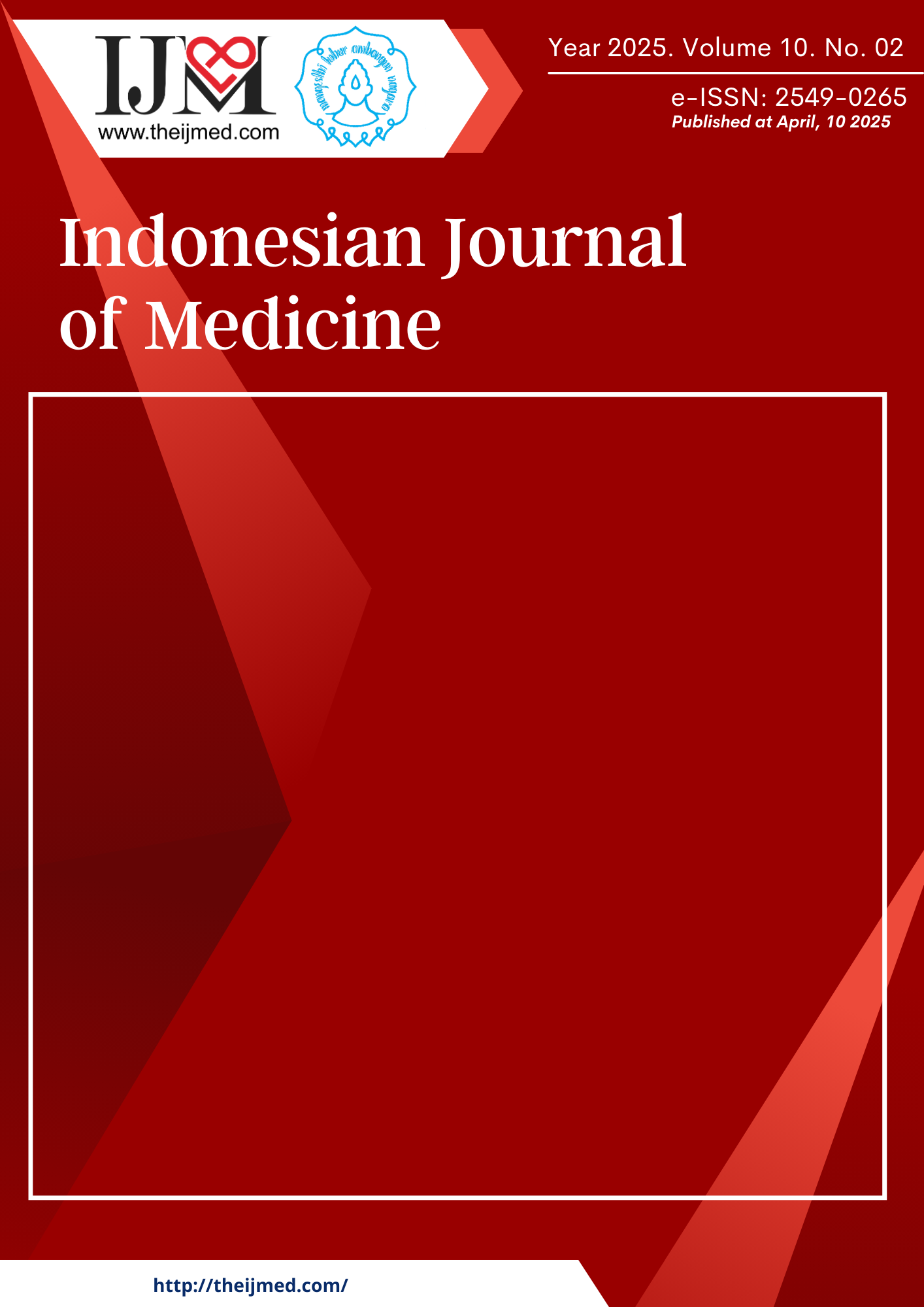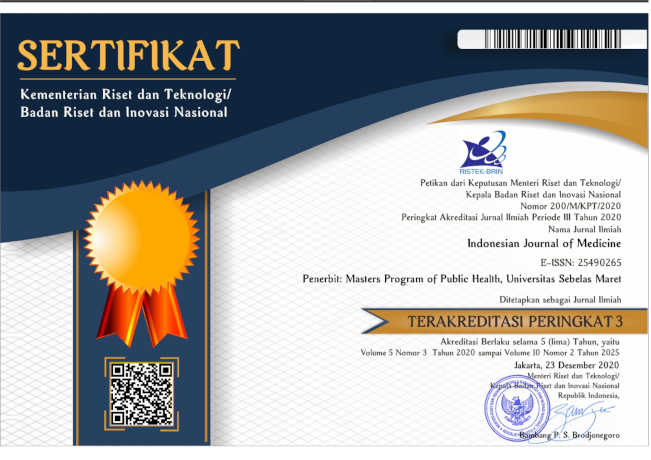The Social Face of Stigma: A Meta-Analysis of Gender, Support, and Living Environment in HIV/AIDS Perception
DOI:
https://doi.org/10.26911/theijmed.2025.10.2.845Abstract
Background: The stigma of society towards ODHA itself is influenced by various factors, where there are three factors that can be used as a benchmark, namely gender, place of residence, and social support. This study aims to estimate the magnitude of the influence of gender, social support and housing on the perception of stigma in people with HIV/AIDS, based on the results of a number of previous primary studies.
Subject and Method: This study is a meta-analysis and systematic review study, with PICO, Population: ODHA patients (People with HIV/AIDS), Intervention: Women, low social support and village dwelling, Comparison: men, high social support and urban dwelling, Ooucome: HIV/AIDS stigma. Primary study searches used electronic databases: PUBMED, BMC, Scopus and Scient Direct published from 2012 to 2022. The keywords used are "people living with HIV" AND "gender" AND "social support" AND "residence" AND "perceived stigma HIV, cross-sectional"". There are 9 English fulltext arithmetic with effect size using adjusted odds ratio from 2012 to 2022. Articles selected with PRISMA Flow and analyzed using RevMan 5.3.
Result: This meta-analysis was conducted on 9 primary studies from India and Ethiopia with a sample = 14,191 HIV/AIDS patients. This study showed that the risk of stigma perception increased with female sex (aOR=1.35, CI 95%=0.75 to 2.46; p=0.320; I²=91%) and rural housing (aOR=1.49; CI 95%=0.89 to 2.47; p=0.130), but it is not statistically significant. The risk of stigma perception decreased with high social support (aOR=0.53; CI 95%=0.32 to 0.90; p=0.020), and the results are statistically significant.
Conclusion: The risk of stigma perception increases with female gender, rural housing and high social support.
Keywords:
gender, social support, residence, perceived stigmaReferences
Adane B, Yalew M, Damtie Y, Kefale B (2020). Perceived stigma and associated factors among people living with HIV attending ART clinics in public health facilities of Dessie City, Ethiopia. HIV AIDS (Auckl). 12:551–557. https://doi.org/10.2147/hiv.s274019.
Ajong AB, Njotang PN, Nghoniji NE, Essi MJ, Yakum MN, Agbor VN, Kenfack B (2018). Quantification and factors associated with HIV-related stigma among persons living with HIV/AIDS on antiretroviral therapy at the HIV-day care unit of the Bamenda Regional Hospital, North West Region of Cameroon. Glob Health. 14(1):56. https://-doi.org/10.1186/s12992-018-0374-5.
Alberti A, Morandi B, Francetti L, Taschieri S, Corbella S (2022). Differentiating gender and sex in dental research: a narrative review. Int J Dent. 2022: 2457748. https://doi.org/10.1155/2022/2457748.
Alemu A, Meskele M, Darebo TD, Handiso TB, Abebe A, Paulos K (2022). Perceived HIV stigma and associated factors among adult ART patients in Wolaita Zone, Southern Ethiopia. HIV AIDS (Auckl). 14:487–501. https://doi.org/10.2147/HIV.S372738.
Asra E, Supriyatni N, Mansyur S (2020). Stigma terhadap orang dengan HIV dan AIDS (ODHA) pada masyarakat di Kelurahan Kayu Merah Kota Ternate Tahun 2019. J Biol Sains Teknol. 2(1): 47–57. https://doi.org/10.52046/biosainstek.v2i01.325.
Charles B, Jeyaseelan L, Pandian AK, Sam AE, Thenmozhi M, Jayaseelan V (2012). Association between stigma, depression, and quality of life of people living with HIV/AIDS (PLHA) in South India: a community based cross sectional study. BMC Public Health. 12: 463. https://doi.org/10.1186/1471-2458-12-463.
Chekole YA, Tarekegn D (2021). HIV-related perceived stigma and associated factors among patients with HIV, Ethiopia: a cross-sectional study. Ann Med Surg (Lond). 71:102921. https://doi.org/10.1016/j.amsu.2021.102921.
Chowdhury S, Chakraborty PP (2017). Universal health coverage: there is more to it than meets the eye. J Family Med Prim Care. 6(2):169–170. https://doi.org/10.4103/-jfmpc.jfmpc_116_17.
Kementerian Kesehatan Republik Indonesia (2021). Kementerian Kesehatan RI: Badan Penelitian dan Pengembangan Kesehatan. [Internet]. Available from: https://www.litbang.kemkes.go.id.
King LA (2012). Psikologi Umum: Sebuah Pandangan Apresiatif Buku 2. Jakarta: Salemba Humanika.
Maharani R (2014). Stigma dan diskriminasi orang dengan HIV/AIDS (ODHA) pada pelayanan kesehatan di Kota Pekanbaru Tahun 2014. JKKI. 2(5): 225–232. https://doi.org/10.25311/keskom.vol2.iss5.79.
Melis T, Fikad Y, Lemma L (2020). Perceived stigma and associated factors among HIV positive adult patients attending antiretroviral therapy clinics at public facilities of Butajira Town, Southern Ethiopia, 2020. HIV AIDS (Auckl). 12:717–724. https://doi.org/10.2147/HIV.S280501.
Olyaeemanesh A, Woldemichael A, Takian A, Sari AA (2019). Availability and inequality in accessibility of health centre-based primary healthcare in Ethiopia. PLoS One. 14(3):e0213896. https://doi.org/10.1371/journal.pone.0213896.
Peltzer K, Pengpid S (2019). Prevalence and associated factors of enacted, internalized, and anticipated stigma among people living with HIV in South Africa: results of the first national survey. HIV AIDS (Auckl). 11: 275–285. https://doi.org/10.2147-/HIV.S229285.
Subedi B, Timilsina BD, Tamrakar N (2019). Perceived stigma among people living with HIV/AIDS in Pokhara, Nepal. HIV AIDS (Auckl). 11:93–103. https://doi.org/10.2-147/HIV.S181231.
Turi E, Simegnew D, Fekadu G, Tolossa T, Desalegn M, Bayisa L, Mulisa D, et al. (2021). High perceived stigma among people living with HIV/AIDS in a resource-limited setting in Western Ethiopia: the effect of depression and low social support. HIV AIDS (Auckl). 13: 389–397. https://doi.org/10.2147/HIV.S295110.
Wowolo G, Cao W, Bosomtwe D, Enimil A, Tarantino N, Barker DH, Galárraga O (2022). The impact of different parental figures of adolescents living with HIV: an evaluation of family structures, perceived HIV related stigma, and opportunities for social support. Front Public Health. 10: 647960. https://doi.org/10.3389/fpubh.2022.647-960.
WHO (2016). Sexually transmitted infections. Fact Sheet. World Health Organization.
WHO (2020) Indonesia: gender dan Kesehatan (Indonesia: gender and health). World Health Organization.
Yang X, Su B, Zhang X, Liu Y, Wu H, Zhang T (2020). Incomplete immune reconstitution in HIV/AIDS patients on antiretroviral therapy: Challenges of immunological non-responders. J Leukoc Biol. (4):597-612. https://doi.org/10.1002/JLB.4MR1019-189R.











